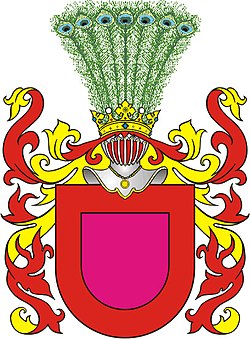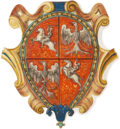| Janina | |
|---|---|
 | |
| Battle cry | Janina |
| Alternative name(s) | Clipeus in Clipeum, Szczyt w Szczycie, Tarcza w Tarczy, Pole w Polu |
| Earliest mention | 1379 (seal) |
| Families | 276 names A Antoniewicz, Antonowicz. B Białobłocki, Białobocki, Białobrocki, Białobrodzki, Białowocki, Białowodzki, Bidzieński, Bidziński, Biedzieński, Bielecki, Bielewski, Bielicki, Bielowski, Brandwicki, Branicki, Branwicki, Brodawka, Broniszewski, Broniszowski, Byszewski. ContentsC Chołubowicz, Chotecki, Chotelski, Churzowski, Chyszowski, Cudzinowski, Czudzinowski, Czyżowski. D Danczykiewicz, Danejkowicz, Denejkowicz, Doruchowski, Duńczykiewicz, Dzirytowicz. F Falisławski. G Gabaniski, Gabański, Gaboński, Gabriałowicz, Gabryałowicz, Gabryjałowicz, Gajewski, Gajle, Galowski, Gardziński, Gawędowski, Giecewicz, Gielczewski, Giełbowski, Giełczewski, Gołembiowski, Gołębiowski, Gołubicki, Gołubiecki, Gołubiew, Gołubowski, Górka, Grabowski, Guliński. H Hanicki, Hołubicki, Hołubowicz, Hołubowski, Hubarewicz. I Imszennik, Iwanin. J Jachniewicz, Jacuński, Janiewicz, Jasniewicz[ citation needed ], Janik, Janikowicz, Janikowski, Janiński, Jankiewicz, Janowicz, Janowiecki, Janowski, Jarociński, Jaroszewski, Jaroszowski, Jaroszyński, Jasiński, Jaszczowski, Jawicki, Jaworski, Jentkiewicz, Jętkiewicz, Jowenko, Jurkiewicz. K Kamiński, Kański, Karski, Kasperowicz, Kaszewski, Kaszowski, Kielczewski, Kiełbowski, Kiełczewski, Kleofas, Kliszowski, Klofas, Kołaczkowski, Kołaczyński, Kołmaczewski, Konracki, Konradzki, Korzeniewski, Korzeniowski, Krampski, Kraski, Krzysztoforski, Krzysztoporski, Kufiński, Kułaczkowski, Kunradzki, Kuszczewski, Kwasek, Kwasibrodzki. L Lachowski, Lendzki, Leński, Lęcki, Lędzki, Liński, Lipnicki, Lipski, Lubecki. Ł Łabęcki, Łabędzki, Łęcki, Łędzki, Łęski. M Maciejewski, Maciejowski, Malski, Mietelski, Mikołajewicz, Milęcki, Miroszowski, Mniowski, Mociewicz, Morozowski, Mszczuj . N Nacewicz, Naczewicz, Narajewski, Narajowski, Narojski, Nasiechowski, Necewicz, Neczewicz, Nepelski, Nieciewicz, Nossek. O Olbęcki, Olbiecki, Olbieński, Olbięcki, Olbiński, Olszbank, Onikiewicz, Opalski, Opocki, Opoka. P Pankowski, Pełka, Piasecki, Pielaszkowski, Podlodowski, Pogłodowski, Polikarp, Potocki, Prawęcki, Przewocki, Przezwocki, Pszonka, Pszonkowski, Putianowicz, Putyanowicz, Pyrka, Pyrski. R Radorzyski, Raduński, Rdzawski, Restarzewski, Rzeczycki, Rzezeński, Rzeżeński. S Sadło, Sadowski, Sawin, Smosarski, Smoszarski, Sobieski, Sopocki, Sopotnicki, Srokowski, Starzyński, Stoiński, Stojecki, Stojeński, Stojeski, Stojewski, Strojewski, Stroński, Suchodolski, Swoboda, Swojkowski, Szczepiecki, Szczypiecki, Szczypski. Ś Świder, Świerczkowski, Święcicki. T Tarnawski, Tchorzewski, Tchórzewski, Tchórzowski, Trymowicz, Tudorowski, Turski. U Ubniński, Unieszowski, Uniszowski, Urniaż, Urzanowski, Urzarzowski, Urzażowski, Usarzewski, Uszacki, Uzarzowski. W Warpęski, Wasilenko, Wasylenko, Waszmuntowski, Weszmunt, Wierciński, Wiernek, Wiernkowski, Wierzbieński, Wierzbięta, Wierzbiński, Wierzynek, Winarski, Winiarski, Włostowski-Pełka, Wojsin, Wojszyk, Wojszym, Wojszyn, Wojtkiewicz, Wolicki, Wrzazowski, Wrzębski, Wszemuntowski, Wydżga, Wysociński, Wyszmuntowski. Z Zacharewicz, Zachwatowicz, Zaduski, Zahutyński, Zawadzicki, Zawadzki, Zawieprski, Zbiluta, Zerzyński, Zielawski, Zulicki, Zyrzyński. Ż Żulicki, Żyliński, Żyrzyński. |
| Cities | Złoczów |
| Divisions | Wilanów, Scutum |
Janina is a Polish nobility clan coat-of-arms. Borne by several noble families descended in the-male line from the medieval lords of Janina (the eponyms of the clan) or legally adopted into the clan upon ennoblement.













